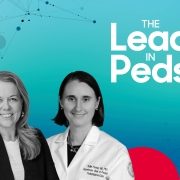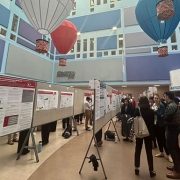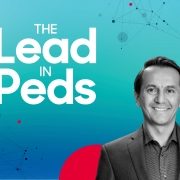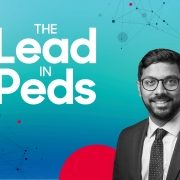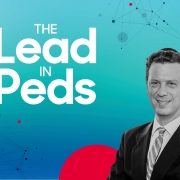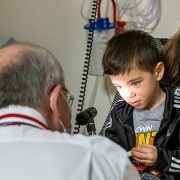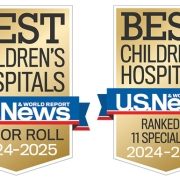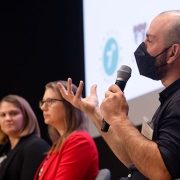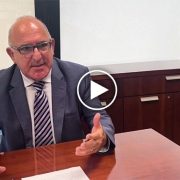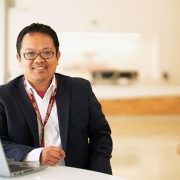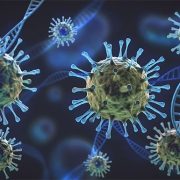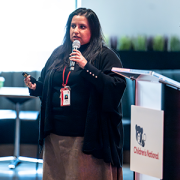REI Week 2025 empowers the future in pediatric research and innovation
Children’s National Hospital hosted its fifteenth annual Research, Education and Innovation Week from March 31–April 4, 2025, bringing together clinicians, scientists, educators and innovators from across the institution to celebrate discovery and collaboration. This year’s theme, “Empowering the Future in Pediatric Research and Innovation with Equity, Technology and a Global Reach,” served as a call to action for advancing science that improves child health both locally and around the world.
Each day of the week-long event featured thought-provoking lectures — now available to watch — dynamic panel discussions, interactive workshops and vibrant poster sessions, all highlighting the diverse and interdisciplinary work taking place across Children’s National.
Centering the patient and the planet
REI Week began on Monday with a powerful keynote lecture from Lynn R. Goldman, MD, MS, MPH, Michael and Lori Milken dean of the Milken Institute School of Public Health at the George Washington University. In her talk, “Children: Uniquely vulnerable to climate-related threats,” Dr. Goldman underscored the urgent need to protect children from the environmental hazards of a changing climate and to integrate climate science into pediatric care and advocacy.
At mid-morning, Mary-Anne “Annie” Hartley, MD, PhD, MPH, director of the LiGHT Laboratory at École Polytechnique Fédérale de Lausanne, introduced the “MOOVE” platform — Massive Open Online Validation and Evaluation of clinical LLMs. Her talk demonstrated how artificial intelligence, when rigorously validated, has the potential to transform clinical decision-making and global health equity.
Monday’s final keynote, “Zinc and childhood diarrhea,” was presented by Christopher Duggan, MD, MPH, director of the Division of Nutrition at Harvard Medical School. Dr. Duggan highlighted the global health impact of zinc supplementation in reducing childhood mortality — a reminder that simple, evidence-based interventions can save millions of lives.
In that first day, the first poster session of the week showcased projects in adolescent medicine, global health, infectious diseases, oncology and more. The session reflected the full breadth of research taking place across Children’s National.
Ambroise Wonkam, MD, PhD, professor of genetic medicine at Johns Hopkins University, then delivered Tuesday’s Global Health Keynote Lecture, “Harnessing our common African genomes to improve health and equity globally.” His work affirmed that inclusive genomics is key to building a healthier world.
Later, the Global Health Initiative event and GCAF Faculty Seminar encouraged attendees to pursue collaborative opportunities at home and abroad, reflecting the growing global footprint of Children’s National research programs.
Transforming education and care delivery
On Wednesday, Larrie Greenberg, MD, professor emeritus of pediatrics, kicked off the day with a Grand Rounds keynote on educational transformation: “Shouldn’t teachers be more collaborative with their learners?” He followed with a CAPE workshop exploring the effectiveness of case-based learning.
The Nursing Sponsored Keynote Lecture by Vincent Guilamo-Ramos, PhD, MPH, LCSW, ANP-BC, PMHNP-BC, FAAN, explored “Redesigning the U.S. broken health system.” He offered an urgent and inspiring call to reimagine pediatric care by addressing social determinants of health.
In the Jill Joseph Grand Rounds Lecture, Deena J. Chisolm, PhD, director of the Center for Child Health Equity at Nationwide Children’s Hospital, challenged attendees to move beyond dialogue into action in her talk, “Health equity: A scream to a whisper?,” reminding researchers and clinicians that advocacy and equity must be foundational to care.
The day continued with a poster session spotlighting medical education, neonatology, urology and neuroscience, among other fields.
Posters and pathways to progress
Throughout the week, poster sessions highlighted cutting-edge work across dozens of pediatric disciplines. These sessions gave attendees the opportunity to engage directly with investigators and reflect on the shared mission of discovery across multiple disciplines, including:
- Neuroscience and Neuroprotection – Novel approaches to brain injury treatment and neurodevelopmental disorders.
- Genetics and Precision Medicine – Advances in understanding genetic predisposition and innovative therapies.
- Health Disparities and Global Health – Strategies to bridge gaps in pediatric healthcare access worldwide.
- Innovative Technology in Pediatrics – Breakthroughs in AI, bioinformatics and medical device development.
Honoring excellence across Children’s National
The REI Week 2025 Awards Ceremony celebrated outstanding contributions in research, mentorship, education and innovation. The winners in each category were:
POSTER SESSION AWARDS
Basic & Translational Research
Faculty: Benjamin Liu, PhD
“Genetic Conservation and Diversity of SARS-CoV-2 Envelope Gene Across Variants of Concern”
Faculty: Steve Hui, PhD
“Brain Metabolites in Neonates of Mothers with COVID-19 Infection During Pregnancy”
Faculty: Raj Shekhar, PhD
“StrepApp: Deep Learning-Based Identification of Group A Streptococcal (GAS) Pharyngitis”
Post docs/Fellows/Residents: Dae-young Kim, PhD
“mhGPT: A Lightweight Domain-Specific Language Model for Mental Health Analysis”
Post docs/Fellows/Residents: Leandros Boukas, MD, PhD
“De Novo Variant Identification From Duo Long-Read Sequencing: Improving Equitable Variant Interpretation for Diverse Family Structures”
Staff: Naseem Maghzian
“Adoptive T Lymphocyte Administration for Chronic Norovirus Treatment in Immunocompromised Hosts (ATLANTIC)”
Graduate Students: Abigail Haffey
“Synergistic Integration of TCR and CAR T Cell Platforms for Enhanced Adoptive Immunotherapy in Brain Tumors”
High School/Undergraduate Students: Medha Pappula
“An ADHD Diagnostic Interface Based on EEG Spectrograms and Deep Learning Techniques”
Clinical Research
Faculty: Folasade Ogunlesi, MD
“Poor Air Quality in Sub-Saharan Africa is Associated with Increase Health Care Utilization for Pain in Sickle Cell Disease Patients”
Faculty: Ayman Saleh, MD
“Growth Parameters and Treatment Approaches in Pediatric ADHD: Examining Differences Across Race”
Post docs/Fellows/Residents: Nicholas Dimenstein, MD, MPH
“Pre-Exposure Prophylaxis (PrEP) Eligibility in the Pediatric Emergency Department”
Staff: Tayla Smith, MPH
“The Public Health Impact of State-Level Abortion and Firearm Laws on Health Outcomes”
Graduate Students: Natalie Ewing
“Patterns of Bacteriuria and Antimicrobial Resistance in Patients Presenting for Primary Cloacal Repair: Is Assisted Bladder Emptying Associated with Bacteriuria?”
Graduate Students: Manuela Iglesias, MS
“Exploring the Relationship Between Child Opportunity Index and Bayley-III Scores in Young Children”
High School/Undergraduate Students: Nicholas Lohman
“Preliminary Findings: The Efficacy, Feasibility and Acceptability of Group Videoconference Cognitive Behavioral Therapy with Exposure and Response Prevention for Treating Obsessive-Compulsive Disorder Among Children and Young People”
Community-Based Research
Faculty: Sharon Shih, PhD
“Assessing Pediatric Behavioral Health Access in DC using Secret Shopper Methodology”
Post docs/Fellows/Residents: Georgios Sanidas, MD
“Arrested Neuronal Maturation and Development in the Cerebellum of Preterm Infants”
Staff: Sanam Parwani
“Intersectionality of Gender and Sexuality Diversity in Autistic and Non-Autistic Individuals”
Graduate Student: Margaret Dearey
“Assessing the Burden of Period Poverty for Youth and Adolescents in Washington, DC: A Pilot Study”
Quality and Performance Improvement
Faculty: Nichole L. McCollum, MD
“A Quality Improvement Study to Increase Nurse Initiated Care from Triage and Improve Timeliness to Care”
Post docs/Fellows/Residents: Hannah Rodriguez, MD
“Reducing Unnecessary Antibiotic Use in a Level IV NICU”
Staff: Amber K. Shojaie, OTD, OTR/L
“Implementing Dynamic Axilla Splints in a Large Burn Patient”
MENTORSHIP AWARDS
Basic Science Research
Conrad Russell Y. Cruz, MD, PhD
Clinical Research
Bench to Bedside Research
Ioannis Koutroulis, MD, PhD, MBA
ELDA ARCE TEACHING SCHOLAR AWARD
SUZANNE FEETHAM NURSING RESEARCH SUPPORT AWARD
Eileen P. Engh, PhD RN
“Rare Disease Organization Lifecycle” Role in Helping Parents with Everyday Life Information Seeking and Connection (RDO-HELIX)
EXPLORATIONS IN GLOBAL HEALTH PILOT AWARDS
Launchpad Awards
Mi Ran Shin, MD, MPH
“Establishing Interdisciplinary Rehabilitation for Birth and Burn Injuries in Ethiopia”
Susan Harvey, MSN, CPNP-AC
“Implementation of Sickle Cell Pilot Program in Ndhiwa Sub County, Kenya”
Meleah Boyle, PhD, MPH
“Understanding and Addressing Environmental Sustainability to Protect the Health of the Children’s National and Global Communities”
Eiman Abdulrahman, MD
“Research Capacity Building to Improve Pediatric Emergency and Critical Care in Ethiopia”
Pilot Awards
Alexander Andrews, MD
“EEG as a Diagnostic and Prognostic Marker in Severe Pediatric Malaria, Blantyre Malawi”
Daniel Donoho, MD & Timothy Singer, MD
“Feasibility Study of a Novel Artificial Intelligence-Based Educational Platform to Improve Neurosurgical Operative Skills in Tanzania”
Hasan Syed, MD
“Bridging the Gap an Educational Needs Assessment for Pediatric Neurosurgery Training in Pakistan”
Sofia Perazzo, MD & Lamia Soghier, MD, MEd, MBA
“QI Mentorship to Improve Pediatric Screening and Follow-up in Rural Argentina”
Benjamin Liu, PhD
“AI-Empowered Real-Time Sequencing Assay for Rapid Detection of Schistosomiasis in Senegal”
Rae Mittal, MD
“Assessment and Enhancement of Proficiency in Emergency Child Neurology Topics for Post-Graduate Emergency Medicine Trainees in India”
Innovation Day ignites bold thinking
Thursday, REI Week shifted to the Children’s National Research & Innovation Campus for Innovation Day, a celebration of how bold ideas and collaborative culture can accelerate progress in pediatric medicine.
Brandy Salmon, PhD, associate vice president of Innovation and Partnerships at Virginia Tech, opened the day with “The Alchemy of Innovation,” focusing on how institutions can build a culture that fuels transformative partnerships.
A multidisciplinary panel discussion moderated by Nathan Kuppermann, MD, MPH, and Catherine Bollard, MBChB, MD, featured Nehal Mehta, MD, Julia Finkel, MD, Kevin Cleary, PhD, Ioannis Koutroulis, MD, PhD, MBA, Francesca Joseph, MD and Patrick Hanley, PhD, who shared how innovation can be advanced and promoted, especially as a core institutional priority.
A shared vision for the future
REI Week 2025 reaffirmed the values that define Children’s National: a commitment to excellence, collaboration and equity in pediatric research and care. As discoveries continue to emerge from our hospital and our research campuses, the connections built and ideas sparked during this week will help shape the future of pediatric health — locally and globally.
By elevating voices from the bedside to the bench, with the support of the executive sponsors Nathan Kuppermann, MD, MBChB, Catherine Bollard, MBChB, MD, Kerstin Hildebrandt, MSHS, Linda Talley, MS, RN, NE-BC and David Wessel, MD, REI Week demonstrated that we must embrace the community in all aspects of our work. Because we know that there are answers we can only get from the patients that we serve—and we need to be their voice.
Research, Education & Innovation Week will be back next year on April 13-17, 2026.
Posters at the REI Week 2025 Monday, March 31 poster session.
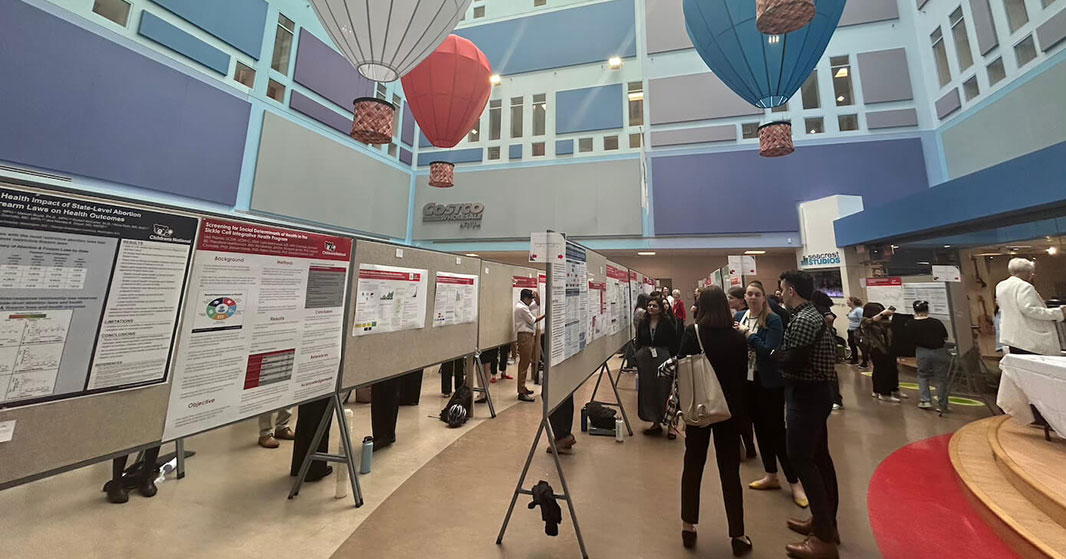
Panelists discuss innovation during REI Week 2025.
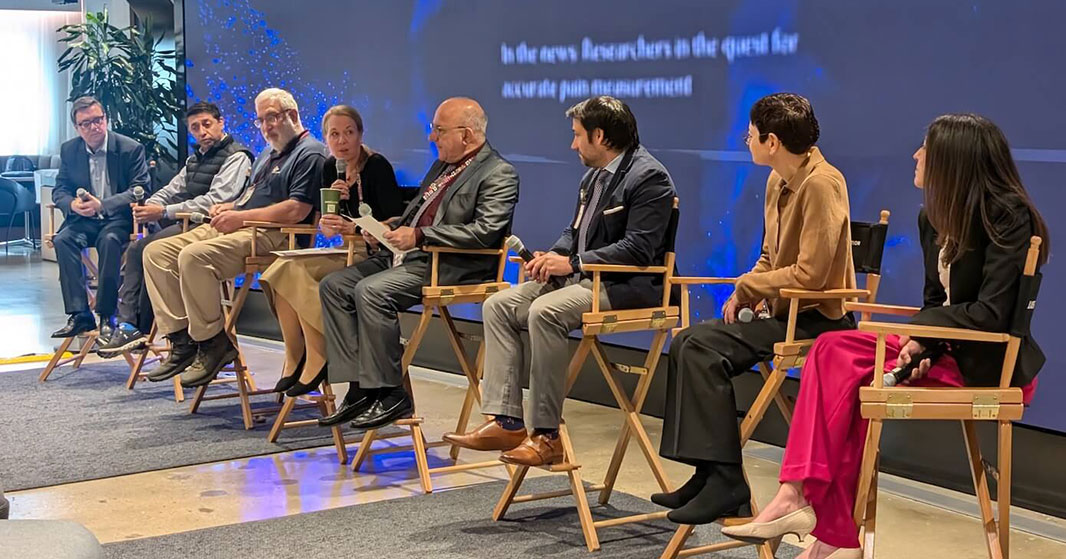
Global Health Initiative community engagement event during REI Week 2025.
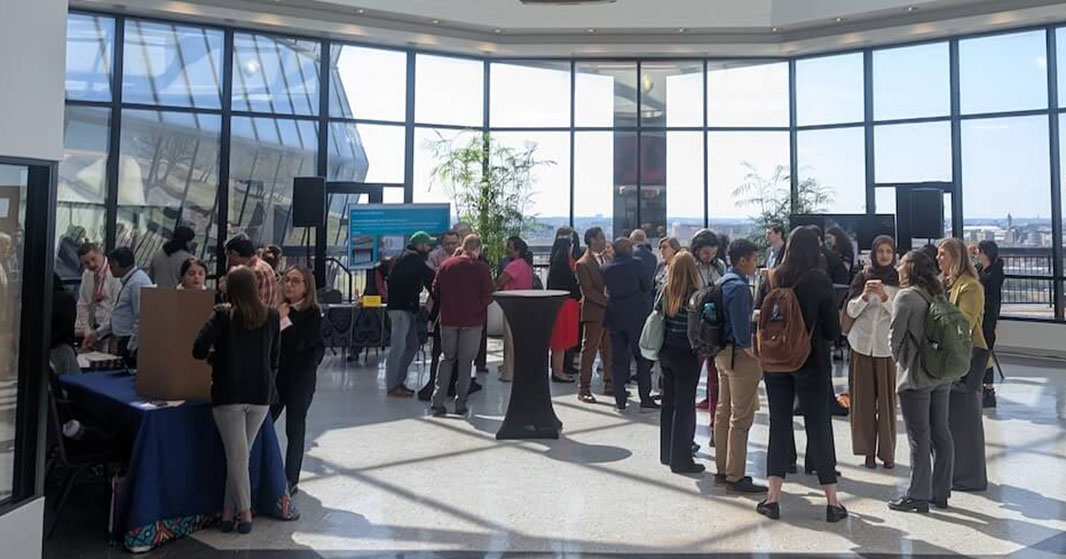
Chris Rees presents his REI Week 2025 lecture.
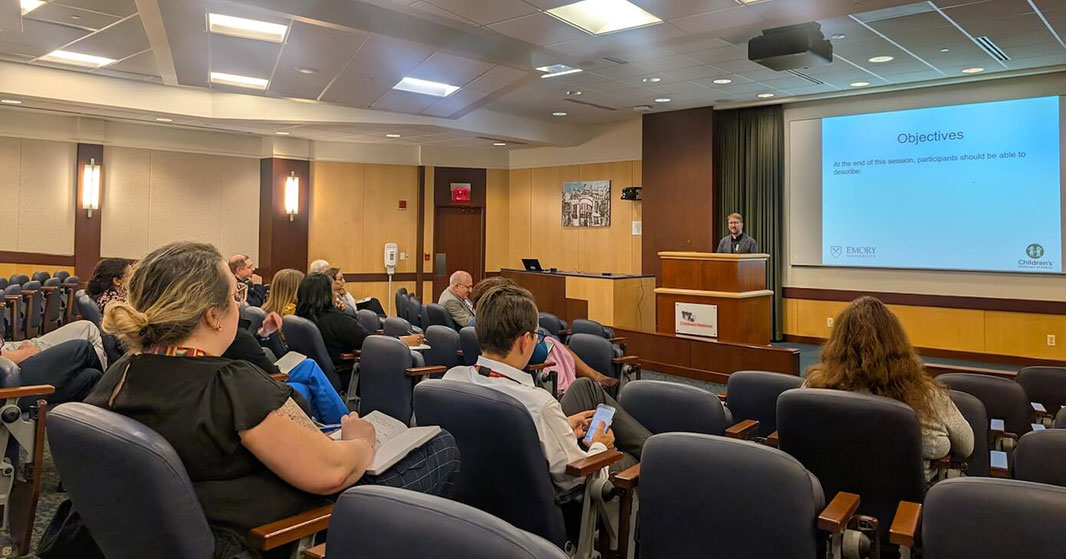
Nathan Kuppermann listens to a presenter during the REI Week 2025 Tuesday, April 1, poster session.
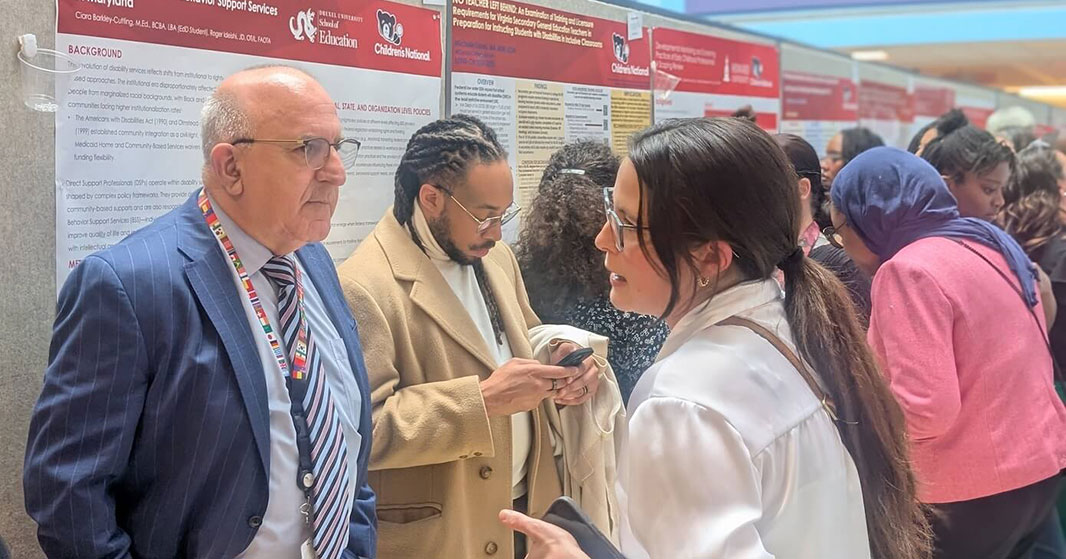
Michelle Riley-Brown, Nathan Kuppermann, Catherine Bollard and Naomi Luban on stage during the REI Week 2025 awards ceremony.
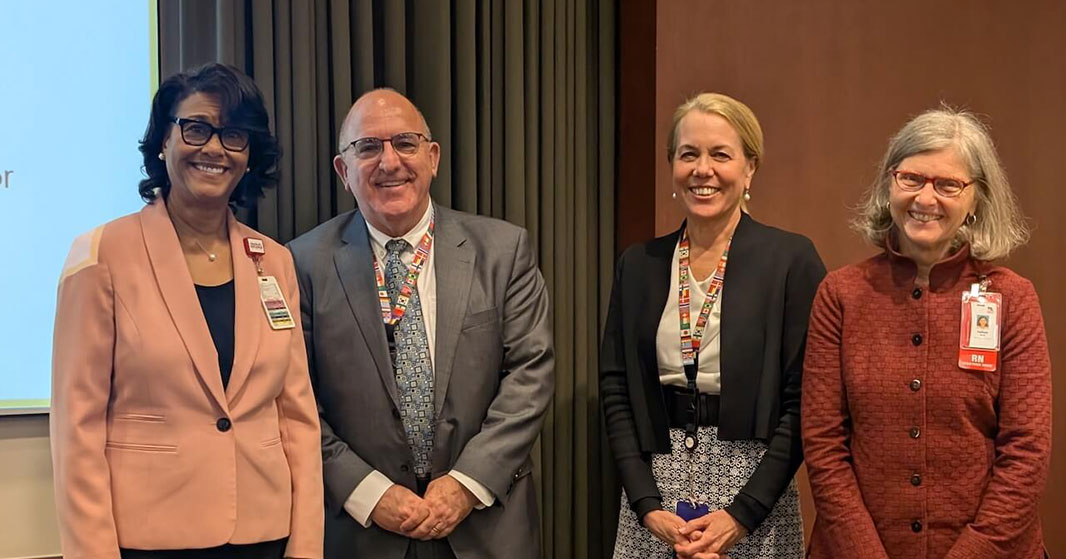
Brandy Salmon presents on innovation programs at Virginia Tech during the REI Week 2025 Innovation Day.
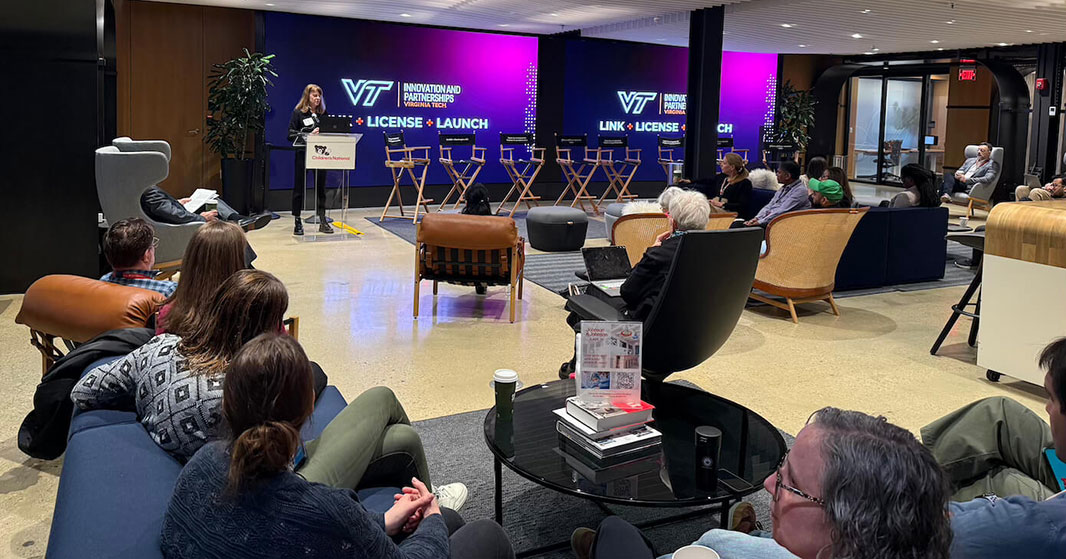
Catherine Bollard listens to a presenter during the REI Week 2025 Monday, March 21 poster session.

Ambroise Wonkman poses for a picture with Children’s National staff.
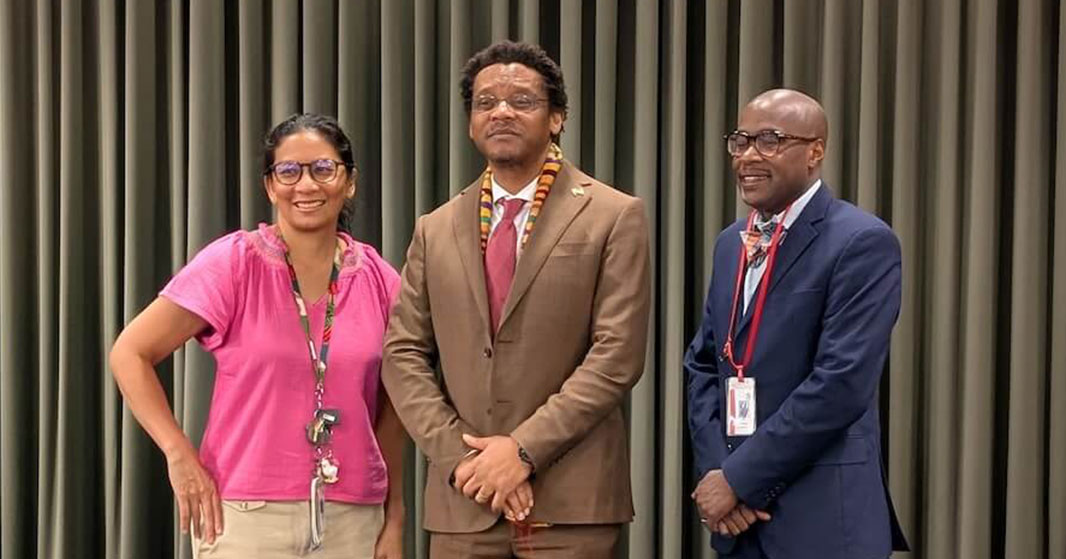
Tanzeem Choudhury presenting during REI Week 2025.
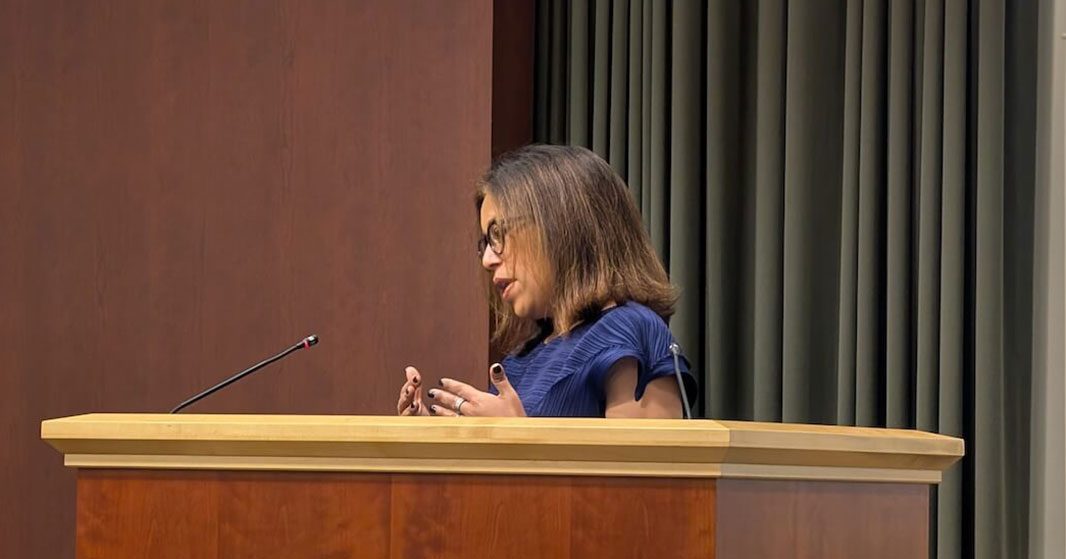
Expanded partnership with Virginia Tech accelerates pediatric cancer research
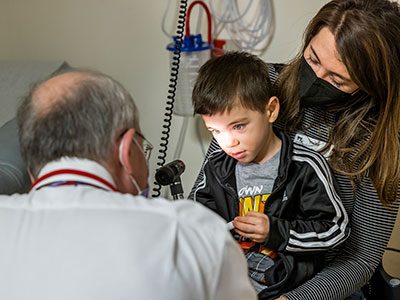
The new partnership will advance pediatric health through innovative discoveries and therapies, with an initial focus on pediatric cancers, including brain tumors.
Children’s National Hospital and Virginia Tech are expanding their research partnership, building on a successful collaboration established in 2019. This partnership will advance pediatric health through innovative discoveries and therapies, with an initial focus on pediatric cancers, including brain tumors.
The partnership brings together Children’s National, ranked among the nation’s top pediatric hospitals by U.S. News & World Report, and Virginia Tech, a leading academic research institution. Together, they aim to deliver transformative advancements to enhance outcomes for children facing devastating diagnoses.
The goals of the research-focused partnership include:
- Accelerating the understanding of the biology, improvements in prevention and treatment of pediatric cancers and other childhood diseases.
- Developing new diagnostic and therapeutic tools to improve care for children.
- Training the next generation of scientists and physician-scientists.
What they’re saying
- “Over the years, our partnership with Virginia Tech has demonstrated the power of combining top-tier research expertise with a shared commitment to improving pediatric health,” said Catherine Bollard, MBChB, MD, senior vice president and chief research officer and director of the Center for Cancer and Immunology Research. “This expansion underscores our belief that by working together, we can accelerate discoveries and develop life-changing therapies for children with cancer and other rare diseases.”
- “Children’s National Hospital has been an important partner for us in biomedical research and innovation,” said Michael Friedlander, PhD, Virginia Tech vice president for health sciences and technology. “Our collaboration deepened with the launch of Children’s National Research & Innovation Campus in Washington, D.C., and now, as our partnership grows even stronger, we’re poised together to take on some of the biggest challenges in cancer research to contribute to the health of children and adults.”
- “Partnering with Children’s National connects us to a world-class clinical trial institute that has been a pioneer in treating brain tumors with focused ultrasound technology, and this presents a unique opportunity to help children and families struggling with cancer,” said Cheng-Chia “Fred” Wu, MD, PhD, a member of the Children’s National Brain Tumor Research Institute and a principal investigator in cancer research and faculty member at the Fralin Biomedical Research Institute in Roanoke and in the Virginia Tech Carilion School of Medicine.“I can’t wait to see where this takes us.”
Big picture
The initial focus of the collaboration is pediatric cancers, including brain tumors — among the most challenging childhood diagnoses. By combining Virginia Tech’s leading-edge technology and research infrastructure with Children’s National’s expertise in pediatric care, the organizations aim to make significant strides in understanding these diseases.
An interdisciplinary approach is at the heart of the ongoing strategy. The collaboration first began with the launch of a 12,000-square-foot Virginia Tech biomedical research facility within the Children’s National Research & Innovation Campus, which opened in 2020. Located on a 12-acre portion of the former Walter Reed Army Medical Center in Washington, D.C., the campus was the nation’s first innovation hub focused exclusively on pediatric research.
Children’s National delivers on the promise in 2024
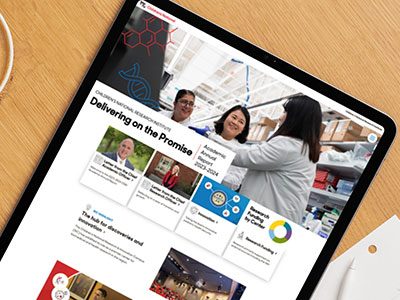
The Children’s National 2023-2024 Academic Annual Report show on a tablet.
Children’s National Hospital has released its 2023-2024 Academic Annual Report, showcasing a year of transformative progress in pediatric medicine. The report highlights achievements across its research centers, institutes and Innovation Ventures, underscoring the hospital’s role as a leader in advancing child health through innovation and collaboration.
“This year’s report reflects the remarkable progress we have made in advancing the frontiers of pediatric medicine,” said Nathan Kuppermann, MD, MPH, Chief Academic Officer and Chair of Pediatrics. “It highlights groundbreaking work across our research centers, institutes, and Innovation Ventures, showcasing the collaborative spirit that drives our mission forward. These achievements underscore our shared commitment to delivering transformative research and the best possible outcomes for children and families.”
Delivering across centers
The report captures the contributions of each of Children’s National’s research centers, each pushing the boundaries of pediatric healthcare:
- Center for Cancer & Immunology Research (CCIR): Delivering on the promise of cell and gene therapies, offering innovative treatments for pediatric cancers and immune disorders.
- Center for Genetic Medicine Research (CGMR): Advancing pediatric genetic medicine through interdisciplinary efforts, addressing complex genetic conditions with cutting-edge science.
- Center for Neuroscience Research (CNR): A year of growth in scientific excellence, advancing the understanding of brain development and neurological conditions.
- Center for Prenatal, Neonatal & Maternal Health Research (CPHNMR): Revolutionizing neonatal care with its pioneering infant brain health neuromonitoring program.
- Center for Translational Research (CTR): Facilitating groundbreaking work by new K awardees and driving translational research to bridge the gap between discovery and clinical care.
- Sheikh Zayed Institute for Pediatric Surgical Innovation (SZI): Leading the way in advanced research projects in pediatric surgery, pushing technological boundaries to improve outcomes for children worldwide.
Taking the lead in innovation through collaboration
Innovation Ventures at Children’s National is advancing pediatric health security, addressing unique challenges with transformative solutions. Meanwhile, the Children’s National Research & Innovation Campus (CNRIC) continues to thrive as a hub for discovery and collaboration, hosting conferences on topics like artificial intelligence in healthcare, cell and gene therapy, and pediatric epilepsy research.
A vision for the future
The report also highlights Children’s National’s focus on integrating cutting-edge technologies like artificial intelligence into its research and clinical practices, as well as addressing global health challenges such as the effects of climate change on children’s health. These efforts reflect the hospital’s commitment to improving outcomes for children everywhere through innovation, teamwork, and forward-thinking leadership.
The 2023-2024 Academic Annual Report serves as a testament to the dedication and expertise of the Children’s National community, showcasing how collaboration and innovation are shaping the future of pediatric healthcare.
Regional powerhouse: Cell and Gene therapy leaders from mid-Atlantic forge connections
Posters at the REI Week 2025 Monday, March 31 poster session.

Panelists discuss innovation during REI Week 2025.

Global Health Initiative community engagement event during REI Week 2025.

Chris Rees presents his REI Week 2025 lecture.

Nathan Kuppermann listens to a presenter during the REI Week 2025 Tuesday, April 1, poster session.

Michelle Riley-Brown, Nathan Kuppermann, Catherine Bollard and Naomi Luban on stage during the REI Week 2025 awards ceremony.

Brandy Salmon presents on innovation programs at Virginia Tech during the REI Week 2025 Innovation Day.

Catherine Bollard listens to a presenter during the REI Week 2025 Monday, March 21 poster session.

Ambroise Wonkman poses for a picture with Children’s National staff.

Tanzeem Choudhury presenting during REI Week 2025.

Nearly 200 biomedical leaders from Washington, D.C., Maryland, and Virginia gathered at the Children’s National Research & Innovation Campus for the 2nd annual Cell & Gene Therapy Symposium. The event showcased groundbreaking developments in rare disease treatments and underscored the importance of regional collaboration.
“By targeting diseases at the cellular level, we are on the cusp of breakthroughs in cell and gene therapy that will transform medicine,” said Catherine Bollard, M.D., M.B.Ch.B., director of the Center for Cancer and Immunology Research (CCIR) at Children’s National Hospital and a host of the symposium. “Progress will accelerate if we build partnerships beyond our own organizations.”
The big picture
Scientists and clinicians have worked for more than two decades to develop cell and gene therapies aimed at treating diseases on a cellular level. The past few years have been particularly promising as investment in science has led to advancements. Children’s National is at the forefront, as one of the first pediatric hospitals in the world to offer commercial gene therapies for sickle cell disease.
Many more treatments for rare diseases are in development at Children’s National and beyond. Leaders at CCIR are actively building collaborations with companies, academic institutions and enterprises across the mid-Atlantic region to accelerate these efforts.
During the symposium, Eugene Hwang, M.D., chief of Oncology at Children’s National, addressed the urgent need for more effective and less toxic treatments for pediatric brain tumors. He highlighted the potential of combining immunotherapies with innovations like low-intensity focused ultrasound, which can open the blood-brain barrier temporarily to improve drug delivery to tumors.
“With collaboration between the lab and clinic, alongside industry partners and even between hospitals, we can finally make strides I haven’t seen in my entire career,” Dr. Hwang said. “It’s an incredibly inspiring time for all of us.”
Why it matters
Experts from organizations as diverse as MaxCyte, ScaleReady, RoosterBio, PSC Biotech, Qiagen, FujiFilm and the Frederick County Office of Economic Development came together for the daylong conversation.
Michael Friedlander, Ph.D., executive director of the Fralin Biomedical Research Institute at Virginia Tech, emphasized the critical role of regional partnerships in fulfilling the potential of these emerging therapies. He pointed to the collaborative research between Children’s National and Virginia Tech on brain tumors, where bioengineers and cancer researchers are working side-by-side to create new treatments.
“We are now able to begin delivering these leading-edge therapies to patients,” Dr. Friedlander said. “For example, those who live in rural settings often have much less access to such frontline medical innovations. By collaborating with Children’s National and gaining access to urban pediatric populations, as well as patients in our more rural area, we can start to bring these therapies to a much broader audience.”
What’s next
Patrick Hanley, Ph.D., chief and director of the Cellular Therapy Program at Children’s National, observed that other regions in the U.S. are uniting to advance scientific discoveries with the backing of government, academia and industry. He hopes to see similar collaboration across the D.C., Maryland, and Virginia area, known as the DMV. Children’s National is leading an initiative called CHARM – the Capital Health and Mid-Atlantic Regenerative Medicine – to bring regional experts together for webinars, networking events and partnership opportunities.
“There’s significant interest in cell and gene therapy worldwide,” said Dr. Hanley, a symposium host. “I see an even greater interest in creating cell and gene therapy hubs. The time is right for our mid-Atlantic region, and I’m excited to see what unfolds in the next five years.”
Winners announced in pediatric medical device competition focused on cardiology
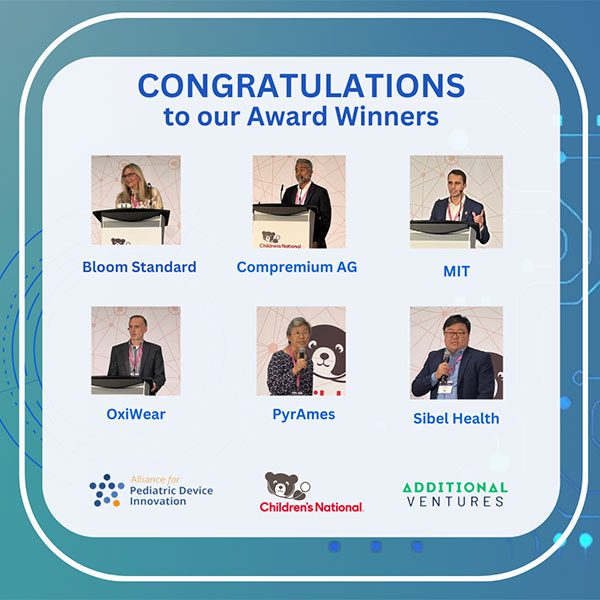 Six medical technology innovators focused on pediatric cardiology were selected to receive grants of $50,000 each in the “Make Your Medical Device Pitch for Kids!TM” competition in Toronto. The funds will help awardees bring their devices to the market and improve care for children with heart conditions.
Six medical technology innovators focused on pediatric cardiology were selected to receive grants of $50,000 each in the “Make Your Medical Device Pitch for Kids!TM” competition in Toronto. The funds will help awardees bring their devices to the market and improve care for children with heart conditions.
The awardees, selected from a highly competitive field of ten finalists, are:
- Bloom Standard, Minneapolis – Autonomous, hands-free ultrasound
- Compremium AG, Bern, Switzerland – Noninvasive central venous pressure estimation for pediatric patients
- Massachusetts Institute of Technology, Cambridge, Mass. – Polymeric auxetic stent to treat pediatric aortic coarctation
- OxiWear, Arlington, Va. – Home measurement of oxygen levels in pediatric congenital heart disease
- PyrAmes Inc., Cupertino, Calif. – Improved, wearable, noninvasive pediatric blood pressure monitor
- Sibel Health, Chicago – Hospital-to-home monitoring for pediatric heart conditions
The competition is presented by the Alliance for Pediatric Device Innovation (APDI), a nonprofit consortium led by Children’s National Hospital and funded through the Food and Drug Administration (FDA), and Additional Ventures, a nonprofit focused on accelerating research progress and improving clinical care for individuals born with single ventricle heart defects. Along with grant funding, awardees gain access to support services and technical expertise provided by APDI and Additional Ventures in areas that include engineering, regulatory, reimbursement, clinical trials study design and data science services.
According to the Centers for Disease Control and Prevention, about 40,000 children are born annually with a congenital heart defect. Children with heart conditions need medical devices tailored to their specific physiological needs. There is a significant unmet need for pediatric devices designed to monitor and treat young patients effectively in cardiology, interventional cardiology, cardiac surgery and electrophysiology. This competitive grant program is designed to identify and support the development and commercialization of devices addressing these needs.
“Congratulations to our awardees, whose innovative technologies show great promise in advancing care for pediatric heart patients,” said Kolaleh Eskandanian, Ph.D., M.B.A., vice president and chief innovation officer at Children’s National and APDI program director and principal investigator. “We are thrilled to welcome this new cohort into our pediatric device accelerator, where they will have the opportunity to collaborate with clinician-scientists at Children’s National and connect to Additional Ventures’ network. Along with these collaborations, the awardees will benefit from a full range of APDI wraparound services designed to support the development of devices specifically for pediatric patients, helping them navigate the complex path to market.”
The competition was held in conjunction with the 12th Annual Symposium on Pediatric Device Innovation, presented by Children’s National and co-located with The MedTech Conference powered by AdvaMed. Focused on transforming pediatric care with exclusive innovations for children, this year’s symposium featured panel discussions and keynote presentations with leading experts in pediatrics and medical technology to exchange information and ideas on critical issues in pediatric device development and pediatric healthcare innovation gaps.
“Additional Ventures is thrilled to support this new class of innovators whose products will make a profound impact in the management and care of pediatric heart patients,” said Additional Ventures CEO Kristie Keller, Ph.D. “We welcome them to our growing community of inventors, researchers and clinicians, and we look forward to working together with our awarded teams and ADPI to bring these products to market. We hope that this competition both inspires and activates the community and brings much-needed new entrants and new ideas to pediatric-first device development.”
APDI is one of five nonprofit consortia in the FDA’s Pediatric Device Consortia grant program. It receives funding to provide a platform of services, expertise and grants that support pediatric innovators in bringing medical devices to the market that specifically address the unmet needs of children. Led by Children’s National, APDI partners include Johns Hopkins University, CIMIT at Mass General Brigham, Tufts Medical Center, MedStar Health Research Institute, MedTech Color and OrthoPediatrics Corp.
Children’s National again ranked among the best in the nation by U.S. News & World Report
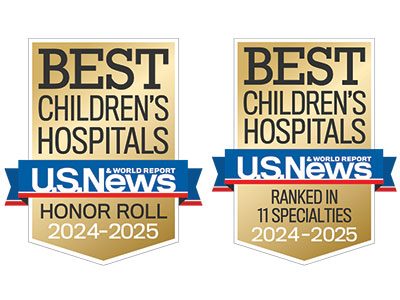 Children’s National Hospital in Washington, D.C., was ranked as a top hospital in the nation by the U.S. News & World Report 2024-25 Best Children’s Hospitals annual rankings. This marks the eighth straight year Children’s National has made the Honor Roll list. The Honor Roll is a distinction awarded to only 10 children’s hospitals nationwide.
Children’s National Hospital in Washington, D.C., was ranked as a top hospital in the nation by the U.S. News & World Report 2024-25 Best Children’s Hospitals annual rankings. This marks the eighth straight year Children’s National has made the Honor Roll list. The Honor Roll is a distinction awarded to only 10 children’s hospitals nationwide.
This year, U.S. News ended ordinal rankings on its Honor Roll. Instead of assigning a numerical rank from 1 to 10, all hospitals on the Honor Roll will be recognized as having attained the highest standards of care in the nation.
In addition, Children’s National tied for #1 pediatric hospital in the Mid-Atlantic region, which includes New York, New Jersey, Delaware, Pennsylvania, the District of Columbia, West Virginia and Virginia. It’s also best in the Mid-Atlantic in Neonatology.
For the fourteenth straight year, Children’s National ranked in 10 specialty services. New this year, U.S. News included behavioral health as a service line in the rankings. Since it’s the first year, there are no ordinal rankings for behavioral health, but the Children’s National program was named one of the top 50 programs in the country.
“In my first year here, I witnessed what makes Children’s National so special — our commitment to collaboration, empowering one another, and charting a bold path forward for pediatric care,” said Michelle Riley-Brown, MHA, FACHE, president and chief executive officer of Children’s National. “I’m proud U.S. News again recognized Children’s National as one of the top in the nation and the highest-ranked pediatric hospital in D.C., Maryland and Virginia. Together, we’ll continue to push the boundaries of care, research and innovation to make a difference for those who matter most — the kids.”
The annual rankings are the most comprehensive source of quality-related information on U.S. pediatric hospitals and recognizes the nation’s top 50 pediatric hospitals based on a scoring system developed by U.S. News.
“For nearly two decades, U.S. News has published Best Children’s Hospitals to empower the parents and caregivers of children with complex medical needs,” said Ben Harder, chief of health analysis and managing editor at U.S. News. “Children’s hospitals appearing on the U.S. News Honor Roll have a track record of delivering unparalleled specialized care.”
The bulk of the score for each specialty service is based on quality and outcomes data. The process includes a survey of relevant specialists across the country, who are asked to list hospitals they believe provide the best care for patients with the most complex conditions.
The Children’s National specialty services that U.S. News ranked in the top 10 nationally are:
- Neonatology (No. 2), led by Billie Lou Short, M.D.
- Neurology and Neurosurgery (No. 5), led by William D. Gaillard, M.D., and Robert F. Keating, M.D.
- Cancer (No. 5), led by Eugene Hwang, M.D.
- Diabetes and Endocrinology (No. 7), led by Andrew Dauber, M.D., MMSc.
- Gastroenterology and GI surgery (No. 8), led by Ian Leibowitz, M.D., Marc Levitt, M.D., Anthony Sandler, M.D., and Timothy Kane, M.D.
- Nephrology (No. 8), led by Marva Moxey-Mims, M.D.
- Orthopedics (No. 9), led by Matthew Oetgen, M.D., M.B.A.
The other four specialties ranked among the top 50 are Behavioral Health, Cardiology and Heart Surgery, Pulmonology and Lung Surgery, and Urology.
New philanthropic support from the United Arab Emirates furthers research breakthroughs and care

His Highness Sheikh Mohamed bin Zayed Al Nahyan, President of the United Arab Emirates (right) visited Children’s National in September 2024.
Continuing a 30-year partnership that has yielded 82 U.S. patents and countless medical breakthroughs for kids and their families, the Government of the United Arab Emirates (UAE) has strengthened its transformational commitment to Children’s National Hospital with a new $35 million donation focused on prenatal, neonatal and maternal health.
The announcement of the new gift comes after a recent visit to the hospital by His Highness Sheikh Mohamed bin Zayed Al Nahyan, President of the United Arab Emirates (UAE), who met with Emirati families and patients receiving care at Children’s National Hospital.
The investment is the latest chapter of a longstanding philanthropic partnership between the UAE and Children’s National. Each year, more than 100 Emirati families travel to Children’s National for advanced pediatric care and life-saving treatments.
This latest investment will bolster various strategic health initiatives, including within the hospital’s Center for Prenatal, Neonatal & Maternal Health Research and the Zickler Family Prenatal Pediatrics Institute.
Researchers in the Center for Prenatal, Neonatal & Maternal Health Research are focused on the role of perinatal factors — including maternal stress, anxiety and depression — on the developing brain of the child. Studies also are revealing the impact of congenital anomalies such as heart disease and acquired conditions such as maternal infection with COVID-19 or Zika virus. New approaches to prenatal and postnatal care promise to optimize long-term outcomes of many hospitalized babies.
“Children in the Washington, D.C., area and across the world benefit greatly from the breakthroughs that have emerged from the incredible decades-long partnership between the UAE and Children’s National,” said Michelle Riley-Brown, President and CEO of Children’s National. “I am deeply grateful for the UAE’s most recent gift. The contribution will positively impact children and families and support the teams of researchers and specialists who dedicate their lives to developing innovative medical care.”
Key milestones
The UAE helped to establish the Sheikh Zayed Institute for Pediatric Surgical Innovation at Children’s National in 2009. Today, the Sheikh Zayed Institute (SZI) has grown into a world-class, self-sustaining research center receiving more than 80% of its funding from grants and outside sources.
This platform for invention is advancing autonomous, robotic surgery. The institute’s researchers believe pediatric surgical outcomes will improve if the precision and delicacy of a robot are incorporated into procedures such as gallbladder removal. SZI is also propelling the use of artificial intelligence to improve pediatric medicine and expand health equity. One example is a deep learning algorithm that uses hand-held ultrasounds to detect early signs of rheumatic heart disease, which kills nearly 400,000 people worldwide each year.
“The lives and health of countless children and families in the Washington area, in the UAE and around the world have been transformed by our partnership,” said Yousef Al Otaiba, the UAE Ambassador to the United States. “Our continued support promises even more breakthrough innovations in pediatric medicine.”
The UAE also supported the opening of the Children’s National Research & Innovation Campus through a 2019 commitment. The campus represents the first pediatric innovation hub of its kind, where scientists, inventors, caregivers, patients’ families and health authorities come together to advance pediatric health.
The Children’s National Rare Disease Institute and Center for Genetic Medicine Research are two of the teams housed at the campus. Together, they are pioneering care for children in the Washington region and abroad as an international referral site for rare disorders. Two examples of their research endeavors include: next-generation genomic testing to better understand how differences in genetic material can affect human health and identifying biochemical analytes.
The UAE opened a medical office in Washington, D.C., in 1991. Since then, thousands of Emirati patients have visited Children’s National for life-changing care for conditions such as congenital heart disease, neurological disorders and cancer. The hospital is currently treating 40 Emirati patients.
“Having our child treated at Children’s National means accessing specialized pediatric care from a renowned institution dedicated to children’s health,” said Hamad Alnuaimi, an Emirati father of a Children’s National patient. “It provides us with confidence and reassurance that our son is receiving the best possible medical attention from experts who understand and prioritize the unique needs of children. For the UAE to have a strong relationship with Children’s National signifies a valuable connection that enhances pediatric healthcare in our country. This partnership allows us to benefit from advanced treatments, medical innovations, and expertise that might otherwise be inaccessible. It represents a commitment to improving the health and well-being of children through international collaboration.”
Transforming pediatric care: How AI is driving the next medical revolution
Posters at the REI Week 2025 Monday, March 31 poster session.

Panelists discuss innovation during REI Week 2025.

Global Health Initiative community engagement event during REI Week 2025.

Chris Rees presents his REI Week 2025 lecture.

Nathan Kuppermann listens to a presenter during the REI Week 2025 Tuesday, April 1, poster session.

Michelle Riley-Brown, Nathan Kuppermann, Catherine Bollard and Naomi Luban on stage during the REI Week 2025 awards ceremony.

Brandy Salmon presents on innovation programs at Virginia Tech during the REI Week 2025 Innovation Day.

Catherine Bollard listens to a presenter during the REI Week 2025 Monday, March 21 poster session.

Ambroise Wonkman poses for a picture with Children’s National staff.

Tanzeem Choudhury presenting during REI Week 2025.

The future of healthcare is unfolding before scientists and clinicians: Doctors are assisted by virtual scribes trained by artificial intelligence. Algorithms are reading MRIs. Smartphones are helping to detect strep throat. Machines diagnose children without access to care.
These and dozens of other artificial intelligence (AI) applications are being tested to enhance pediatric healthcare, and many were on display at the 2nd annual Children’s National Hospital-Virginia Tech Symposium on AI for Pediatric Health at the Children’s National Research & Innovation Campus.
Some highlights from the daylong conversation about the future of pediatric medicine, augmented by AI and generative AI models capable of producing new and critical content:
- Marius George Linguraru, D.Phil., M.A., M.Sc., the Connor Family Professor in Research and Innovation and principal investigator in the Sheikh Zayed Institute for Pediatric Surgical Innovation: “Children are just not mini-adults. In pediatric care, we train pediatric specialists because kids die from different diseases than those that kill adults. Children also suffer from very impactful and rare conditions. If we train pediatric specialists well, we have to train AI algorithms in the same fashion.”
- Rowland Illing, M.D., Ph.D., chief medical officer and director of global healthcare and nonprofits at Amazon Web Services: “In a short period of time, the complexity of the models available is astounding. Generative AI, just like AI, can impact outcomes at every step of the patient pathway, including the clinical workflow, care management and patient engagement. By creating a specific use case with generative AI, every step can be optimized to be smarter, which ultimately leads to improved patient care and outcomes.”
- Children’s National Chief Academic Officer Nathan Kuppermann, M.D., M.P.H.: “AI in pediatric health is not just about identifying rare diseases. Its potential includes all aspects of clinical care, clinical operations, education and research. It has the potential to help educators enhance the novelty and impact of their methods and advance research with powerful tools to gather and analyze data.”
- Alda Mizaku, vice president and chief data and artificial intelligence officer at Children’s National: “What excites me most about our future is the endless possibilities. We can use AI and data to uncover many things: rare diseases, operational efficiencies, time-saving and cost-saving solutions. This has to be done in a responsible way, and we must look at what some of the guardrails need to be.”
Throughout the day, expert panels offered insights into regulatory pathways to deploy AI in pediatric drugs and devices. The Food and Drug Administration’s Office of Science and Engineering Laboratories also provided guidance on collaborative tools for improving the representation of children and perinatal patients in AI-powered medical devices.
Moving the field forward
Early adopters of AI at Children’s National shared applications already under investigation, including efforts to segment and measure brain tumors on imaging, weigh the risk of strep throat with a smartphone camera and detect rheumatic heart disease with portable technology and an algorithm.
Dr. Linguraru, an expert in healthcare AI, said that artificial intelligence is no longer a hypothetical technology but is already remaking the healthcare system. “AI is here. What matters now is how we use it and how we train doctors to use it well,” he said.
The big picture
Through growing partnerships, Children’s National experts are teaming up with researchers at Virginia Tech on a series of AI-driven projects aimed at advancing pediatric health, including programs to rethink privacy in federated learning, forecast emergency department surges, extract clinical variables from documents to predict sepsis risks, identify rare genetic syndromes in children, and predict single-cell responses to genetic perturbations in pediatric developmental disorders.
Naren Ramakrishnan, Ph.D., director of the Sanghani Center at Virginia Tech and the Thomas L. Phillips Professor in the College of Engineering, said the partnership between the two academic centers is changing healthcare already and will continue to as the organizations offer future seed grants to support innovation in cardiology, neuroscience and oncology. “The roots have borne fruit,” he said.
Breaking free of illness: Experts explore solutions for chronic pediatric disorders
Posters at the REI Week 2025 Monday, March 31 poster session.

Panelists discuss innovation during REI Week 2025.

Global Health Initiative community engagement event during REI Week 2025.

Chris Rees presents his REI Week 2025 lecture.

Nathan Kuppermann listens to a presenter during the REI Week 2025 Tuesday, April 1, poster session.

Michelle Riley-Brown, Nathan Kuppermann, Catherine Bollard and Naomi Luban on stage during the REI Week 2025 awards ceremony.

Brandy Salmon presents on innovation programs at Virginia Tech during the REI Week 2025 Innovation Day.

Catherine Bollard listens to a presenter during the REI Week 2025 Monday, March 21 poster session.

Ambroise Wonkman poses for a picture with Children’s National staff.

Tanzeem Choudhury presenting during REI Week 2025.

When new patients with chronic illnesses come to Roberta DeBiasi, M.D., M.S., division chief of Infectious Diseases, they are often drained of energy, far behind in school and fatigued by the lack of coordinated care among multiple specialists. She envisions a better way to care for these children: a data-driven, multidisciplinary clinic that can help diagnose and treat disorders facing chronically ill children.
In a keynote address, Dr. DeBiasi laid out her vision for improving care during the 7th annual symposium hosted by Children’s National Hospital and the National Institute of Allergy and Infectious Diseases (NIAID): “A new paradigm: Infection-associated chronic illnesses (IACI) affecting children.” Experts from across the country came together to discuss these IACIs, the importance of finding biomarkers to diagnose and monitor them, data-driven therapeutics to treat them, and the urgent need for protocols to guide physicians.
The patient benefit
A range of IACIs – including long COVID, Lyme disease, postural orthostatic tachycardia syndrome (POTS), dysautonomia and more – are stealing normal, active lifestyles from children. Dr. DeBiasi said patients need researchers who understand disease pathogenesis and have standardized disease classification to diagnose and treat these disorders. Because of the complexity of these cases, care delivery and coordination also need to change. Patients, she said, would best be served by beginning with a three-hour appointment in a multidisciplinary clinic with experts from behavioral health, rehabilitative medicine and other specialties.
“When one of these patients comes to us, we feel helpless as physicians,” Dr. DeBiasi said. “There’s no diagnostic, and we don’t know how to treat them…. It is, to me, very energizing that we’re going to be able to have a coordinated way to help these families. But to do that, we have to have standardized disease classification.”
Moving the field forward
In 2017, NIAID and Children’s National launched a clinical research partnership devoted to advancing the health of children with allergic, immunologic, auto-inflammatory and infectious diseases through collaborative research and education. The partnership — co-led by H. Clifford Lane, M.D., NIAID’s deputy director for Clinical Research and Special Projects, and Catherine Bollard, M.D., M.B.Ch.B., director of the Center for Cancer and Immunology Research at Children’s National — promotes the prevention, diagnosis, treatment and cure of these childhood diseases. Every year, the partnership organizes and funds a symposium to explore cutting-edge research and pressing issues in pediatric care.
At this year’s gathering, experts examined the specifics of various disorders, including Alexandra Yonts, M.D. She provided new data from the Children’s National Post-Covid Program and explained that patients “are clamoring” for help with symptom management.
“There have been virtually no randomized, controlled trials and very little evidence on any sort of aggressive treatments, or pharmaceutical management options, especially in the pediatric population,” Dr. Yonts said. “Upon recent attendance at some long COVID meetings, there is an expressed concern, especially among pediatric providers, about trying medications off-label in these long COVID patients.”
Miss the symposium? You can learn more about the science they explored in the symposium’s recording on topics including:
- Potential overarching mechanisms of disease, including pathogen- and host-mediated factors.
- Identifying potential biomarkers for chronic illnesses
- Treatments and multidisciplinary approaches for patients with IACIs
- Patient advocacy
New federally supported hub to advance solutions for pediatric health emergencies
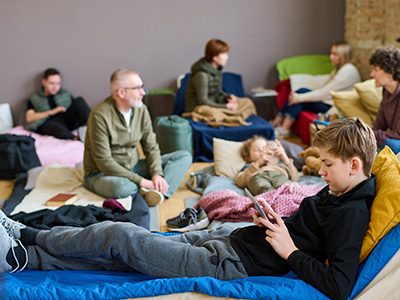 Clinicians caring for children are often left to rely on off-label devices and medications approved for adults, especially during public health crises, national disasters and other emergencies. To address this critical gap, Children’s National Hospital is launching a 10-year partnership with the federal Biomedical Advanced Research and Development Authority (BARDA) — valued at $1.5 million per year, with the possibility of an additional funding boost of up to $515 million.
Clinicians caring for children are often left to rely on off-label devices and medications approved for adults, especially during public health crises, national disasters and other emergencies. To address this critical gap, Children’s National Hospital is launching a 10-year partnership with the federal Biomedical Advanced Research and Development Authority (BARDA) — valued at $1.5 million per year, with the possibility of an additional funding boost of up to $515 million.
This new pediatric-focused hub will be known as the SPARK Hub — or the Hub for Special Populations Acceleration, Research and Knowledge for Innovations in Pediatrics. It will join a network of four existing BARDA hubs to develop various tools for national health emergencies, including infectious disease outbreaks or chemical, biological, radiological and nuclear attacks. The new opportunity for Children’s National positions the organization as a leader among those working to ensure clinicians and their patients have the resources they need in crises, approved for kids and ready for clinical use.
BARDA is part of the Administration for Strategic Preparedness and Response within the U.S. Department of Health and Human Services (HHS), which leads the nation’s medical and public health preparedness, response and recovery efforts during disasters and public health emergencies. The new SPARK Hub led by Children’s National seeks to accelerate innovations that can detect, prevent or respond to the medical consequences of a health security threat for children. SPARK’s scope includes drugs, biologics, devices, diagnostics and digital health solutions that improve prevention, readiness and response.
Kolaleh Eskandanian, Ph.D., M.B.A., P.M.P., vice president and chief innovation officer at Children’s National and principal investigator of SPARK Innovations in Pediatrics, said the hospital was honored to take on this role, which “underscores our commitment to advancing the health and safety of children during public health emergencies.”
“To tackle the complex challenges in developing pediatric medical countermeasures, we have assembled an exceptional team of pediatrician-scientists,” Dr. Eskandanian said. “Their expertise will be instrumental as we partner with BARDA on this vital mission, ensuring that our most vulnerable populations receive the care and protection they deserve.”
Children’s National will lead the hub with its SPARK partners: BioHealth Innovation, Consortia for Improving Medicine with Innovation and Technology (CIMIT) at Mass General Brigham, and University Hospitals Rainbow Babies and Children’s. Johnson & Johnson Innovation JLABS and BLUE KNIGHT™ join the team as strategic industry partners.
The BARDA Accelerator Network aims to provide comprehensive support to health security innovators, startups and BARDA portfolio companies. Dr. Eskandanian said that innovators have ideas for devices, but they often could benefit from wrap-around support to accelerate their development through technical guidance, business and commercialization expertise, and resources. The network will facilitate the rapid development, evaluation, validation and commercialization of medical countermeasures.
“One of the critical challenges we face in safeguarding our children during public health emergencies is the limited medical countermeasures specifically approved for pediatric use,” Dr. Eskandanian said. “This creates significant ethical, legal and operational dilemmas when considering whether to use untested or off-label options for our youngest and most vulnerable populations.”
Children’s National has in-depth experience leading nonprofit accelerator programs to spur innovation in healthcare. It is currently serving its 11th year as leader of one of five pediatric consortia funded by the U.S. Food and Drug Administration, the Alliance for Pediatric Device Innovation, which focuses on bringing patients medical devices specifically evaluated and labeled for use in pediatrics.
Children’s National is also one of two leading hospital sites for the Pediatric Pandemic Network (PPN), which aims to empower healthcare systems and communities to provide high-quality, equitable care to children every day and in crises. The Health Resources and Services Administration, a part of HHS, funds the PPN.
Children’s National summit unites 200+ to bridge health and education
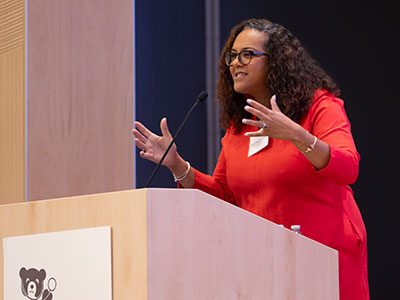
Keynote speaker, Maya Martin Cadogan, executive director, Parents Amplifying Voices in Education (PAVE).
More than 200 attendees from 35 organizations took part in the Children’s National Hospital’s School Health Summit to build strong academic foundations and help launch students into careers. The event, held at the Children’s National Research & Innovation Campus, showcased the Children’s National school-friendly health system framework, school health initiatives and partnerships across the Washington, D.C., area and fostered networking and new relationships between the health and education sectors. Over 80 school nurses from Children’s School Services in the District of Columbia attended the event as part of their summer professional development programming.
Summit highlights
Tonya Vidal Kinlow, M.P.A., vice president of Community Engagement, Advocacy & Government Affairs at Children’s National, delivered opening and closing remarks.
“We believe that addressing school attendance and offering career training programs can powerfully impact students’ academic success and build the foundation for healthy, successful lives,” Kinlow said.
The keynote speaker, Maya Martin Cadogan, executive director of Parents Amplifying Voices in Education (PAVE), shared valuable insight on the important role that parents and caregivers have in advocating for their children’s health through collaborations with health and educational systems.
“Our parent leaders are policy experts, fierce advocates and community connectors. We work with schools, elected officials, policymakers and other leaders, including our partners at Children’s National, to advance a parent-led agenda for systems change in our nation’s capital,” said Cadogan.
A panel of experts who provide school-based services around the region discussed challenges and potential solutions for improving healthcare and education in under-resourced communities. A panel on youth engagement and voices in healthcare also discussed strategies to engage youth in healthcare career opportunities.
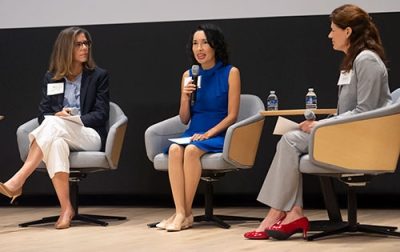
Sara Johnson, Ph.D., professor of pediatrics, Johns Hopkins University School of Medicine; Desiree de la Torre, M.B.A., M.P.H., executive director, Community and Government Affairs, Children’s National and Arethusa Kirk, M.D., pediatrician and vice president, Population Health & Clinical Strategy, United Healthcare.
Panel topics and participants
- Panel 1 – Innovations addressing chronic absenteeism and increasing access to care
Moderator: Arethusa Kirk, M.D., vice president of Population Health & Clinical Strategy at United Healthcare
Panelists:- Andrea Boudreaux, Psy.D., M.P.H., M.A., F.A.C.H.E., executive director at Children’s School Services
- Desiree de la Torre, M.B.A., M.P.H., executive director of Community and Government Affairs at Children’s National
- Sara Johnson, Ph.D., pediatrics professor at the Johns Hopkins University School of Medicine
- Hope Rhodes, M.D., M.P.H., F.A.A.P., medical director of THEARC at Children’s Nationa
- Panel 2: Youth engagement across the region
Moderator: Reneé Roberts-Turner, D.H.A., M.S.N, R.N., N.E.-B.C, C.P.H.Q., executive director of nursing excellence for Child and Family Services at Children’s National
Panelists:- Andrea Zimmermann, director of the Advanced Technical Center at the D.C. Office of the State Superintendent of Education
- Darcel Jackson, C.P.X.P., L.S.S.G.B., manager of Patient Experience and Patient and Family Engagement at Children’s National
- Iana Clarence, M.P.H., former Children’s National intern and public health analyst at the Office of Population Health for the U.S. Department of Health and Human Services
As a School-Friendly Health System, Children’s National ensures all children reach optimal health and achieve their full academic potential. Children’s National is committed to addressing school attendance and career training, which can powerfully impact students’ academic success and build the foundation for healthy, successful lives. The health and education sectors must build trusted partnerships and share decision-making with families and schools.
This event was sponsored by the United Health Foundation and Children’s National Child Health Advocacy Institute through the leadership of Kinlow and Nathaniel Beers, M.D., M.P.H., F.A.A.P.
Q&A with Dr. Kuppermann: Collaboration is critical for scientific success
Nathan Kuppermann, M.D., M.P.H., is taking on a pivotal role at Children’s National Hospital as executive vice president, the new chief academic officer (CAO) and chair of Pediatrics to continue growing the institution’s reputation as a world-class research hospital. He brings more than 30 years of clinical experience in pediatric emergency medicine and research to the leadership role, where he will oversee nearly 2,000 active research projects at the Children’s National Research Institute.
Dr. Kuppermann knows that science drives cures and improved outcomes. Early in his career, he received enhanced research training at the Harvard School of Public Health, where he laid the groundwork to become a globally recognized clinical researcher. He has studied when to order CT scans for children with head, abdominal and neck trauma to minimize radiation exposure, how to best manage children with diabetic ketoacidosis, infants with febrile illnesses and other complex questions in pediatric emergency medicine that require a multidisciplinary research approach to improve clinical care.
Dr. Kupperman is thrilled to join the scientific community in the nation’s capital, which he sees as a global city where he can authentically share his culturally rich background. He is the son of Brazilian immigrants — a chemical physicist and an organic chemist — and he married a pediatric endocrinologist whose parents are from Mexico and Germany. They have three daughters, and their youngest was adopted from Guatemala. As a family, they travel extensively, and he cares deeply about global health, having served as associate dean for Global Health at UC Davis.
A high school point guard who still plays basketball, Dr. Kuppermann runs his team’s offense on the court, choreographing the flow of each game to optimize his team’s strengths. The position requires peripheral vision to get the ball to the right player and make everyone look good. He sees parallels with his new role as CAO.
Q: What is your approach to research in pediatric healthcare?
A: Fundamentally, my philosophy around research is that we all need to collaborate. When I started doing my own research, I realized over time that to have big, impactful studies, two things had to happen: First, you need to work with people who have expertise beyond your own. I’m a big believer in team science and bench-to-bedside research, collaborating with people with complementary research skills.
Second, I realized that in pediatric research, you must collaborate in research networks to ensure your sample size has enough patients and patients from diverse populations to have definitive results and generalizable data.
Q: What values will you bring to the new role?
A: Three key elements come to mind. First, I’m a big believer in transparent communication, which is the root of everything good in life, whether it’s with your science, your friendships or your family.
I’m a big believer in team science. We all have certain areas of expertise, but if we want to combine our expertise to impact children and improve their health, we need to work together in teams, bringing together basic science researchers, clinicians, information technology specialists, knowledge-translation specialists and disseminators.
Finally, I am a cheerleader for science. As you develop your own science, you also are responsible for leading the next generation of scientists. I’ve spent as much time being a scientific mentor as I have working to discover new knowledge through scientific inquiry.
Q: You talk extensively about your family’s international roots and how it drives your work. What is the role of diversity in medicine and how does that guide you?
A: Diversity is fundamental to healthcare. We in the medical community recognize the disparities in the care we deliver, which I’ve studied in my research. Diversity must not only be a research focus, but our teams must be diverse to better investigate — and work to resolve — these inequities of care.
Children’s National is both a hospital that is mindful of its immediate community and an institution that greatly values the diversity of its patients and its staff. It’s also highly ranked in research and cares deeply about global health, all of which are drivers in my work.
When I considered the potential of coming to Children’s National, I thought I might be able to help this already great institution further its mission by serving its immediate community, growing and developing its global health programs, and taking research here from its already great bones and accomplishments to the next level.
Q: What approach do you bring to clinical care?
A: When I do a research study and enroll patients into a clinical trial, I think about the patient and others the research can impact. I frequently think of a quote by the late Paul Brodeur, a scientific writer who wrote a lot about asbestos, which is very powerful and meaningful to me: “Statistics are humans with the tears wiped away.”
And what it means to me is that we must be mindful as researchers that we’re talking about humans with our research. We’re not just talking about numbers, and we’re not just talking about getting grants and papers. We’re talking about how we can elevate the evidence and translate it to the bedside to improve the lives of humans.
Expanding team innovates to take on pediatric brain tumors
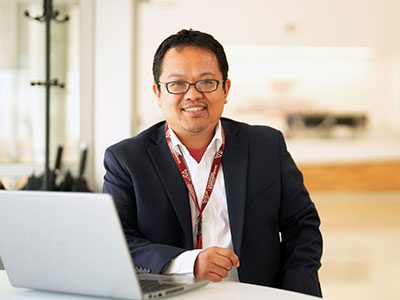
Cheng-Chia “Fred” Wu, M.D., Ph.D., joins the team at the campus as an assistant professor at Virginia Tech’s Fralin Biomedical Research Institute. Image credit: Fralin Biomedical Research Institute.
Experience, talent and technology are coming together at the Children’s National Research & Innovation Campus to solve the complex challenges of treating pediatric brain tumors through a growing partnership between Children’s National Hospital and Virginia Tech.
Cheng-Chia “Fred” Wu, M.D., Ph.D., joins the team at the campus as an assistant professor at Virginia Tech’s Fralin Biomedical Research Institute. He hopes to improve treatment for pediatric brain tumors and other cancers by leveraging technological advances in focused ultrasound and studying how this modality can be combined with other novel therapies. Children’s National physicians and scientists are collaborating with Virginia Tech scientists to develop these new approaches.
Why we’re excited
Catherine Bollard, M.D., M.B.Ch.B., director of the Center for Cancer and Immunology Research and interim chief academic officer at Children’s National, said collaborations — including the partnership between Children’s National and Virginia Tech — are essential to solving formidable scientific challenges.
“We are thrilled to be working with Dr. Wu to develop cutting-edge therapeutics for pediatric brain tumors,” Dr. Bollard said. “With Dr. Wu’s experience and the talents of our team at Children’s National, I have great hope that we will be able to combine our novel technologies and therapies to provide tremendous breakthroughs for treating pediatric patients with brain tumors.”
Before joining Virginia Tech, Dr. Wu was an assistant professor of radiation oncology at Columbia University Irving Medical Center in New York, where he treated pediatric cancers and central nervous system malignancies.
“Partnering with Children’s National connects us to a world-class clinical trial institute that has been a pioneer in treating brain tumors with focused ultrasound technology, and this presents a unique opportunity to help children and families struggling with cancer,” Dr. Wu said. “I can’t wait to see where this takes us.”
Dr. Wu played a key role in the Initiative for Drug Delivery Innovation for Childhood Brain Tumors at Columbia, developing a bench-to-bedside platform to facilitate the translation of promising technologies for targeted drug delivery in children with brain tumors.
Within three years, the team demonstrated the safety and feasibility of using focused ultrasound in the brainstem and adding radiation in preclinical models. They then opened two clinical trials for kids with relapsed diffuse midline glioma, an aggressive and difficult-to-treat brain tumor that occurs in the brain stem, thalamus and spinal cord.
What’s ahead
Dr. Wu will be involved in a wide range of research touching both organizations, including veterinary medicine and biomedical engineering at Virginia Tech.
Michael Friedlander, Ph.D., executive director of the Fralin Biomedical Research Institute at Virginia Tech Carilion and vice president for health sciences and technology at Virginia Tech, welcomed Dr. Wu’s experience as a pediatric radiation oncologist, translational physician-scientist and clinical trialist who has led an innovative drug delivery program.
“He is armed with a unique set of skills to identify promising new technology and implement it in areas of great need for treatment of pediatric cancers,” Dr. Friedlander said. “We are absolutely delighted to have Dr. Wu as part of the team. He represents a powerful new part of the strong partnership between Virginia Tech and Children’s National Hospital for addressing pediatric brain cancer.”
Untangling the root of long COVID with research
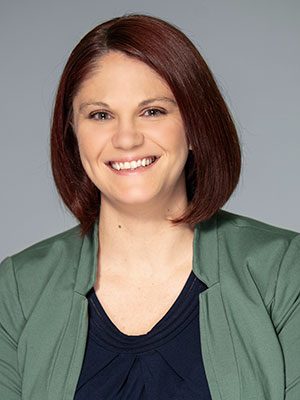
Understanding and treating long COVID is still in its early days, but Dr. Yonts is beginning to see trends, along with hope for symptom relief.
A child who forgets the alphabet or spends 20 hours a day on the sofa will get a pediatrician’s attention. In late 2020, a stream of post-COVID patients just like this started presenting in the clinic of Alexandra Yonts, M.D., an infectious diseases specialist at Children’s National Hospital. Dr. Yonts quickly recognized the need to understand these patients and worked with hospital leadership to open the Pediatric Post-COVID Program, putting her at the forefront of clinicians and researchers investigating the disorder.
Understanding and treating long COVID is still in its early days, but Dr. Yonts is beginning to see trends, along with hope for symptom relief. She will present detailed data from a retrospective study of 254 post-COVID patients at the 2024 Children’s National-NIAID annual symposium, A New Paradigm: Infection-Associated Chronic Illnesses Affecting Children. She’ll discuss her findings on the patients’ symptoms at presentation, trajectory over time and a cluster analysis of symptom grouping. She gave an overview of her research and clinical work to Innovation District.
Q: What are you seeing in the Pediatric Post-COVID Program?
A: In the Infectious Diseases clinic, we had historically seen about one patient a month with prolonged fatigue or other persistent symptoms after an infection. Yet when COVID started, we noticed an increase in those patients. By late 2020, the numbers were increasing significantly, along with an uptick in appointment requests. We knew we needed to start a Pediatric Post-COVID Program, which launched in May 2021.
From the beginning and continuing to this day, severe fatigue is the most common reason kids come to our clinic, as is the case with adults. This ranges from marathon runners who can’t run a half-mile to those sleeping on the couch for 20 hours a day. We’re still researching the factors affecting this wide spectrum of symptoms.
Cognitive issues — often referred to as brain fog — are also significant. These can be seen as attention issues, such as difficulty remembering the alphabet in younger children or focusing in class for older children. Many kids have gastrointestinal problems like nausea, vomiting and abdominal pain. There’s also a prevalence of dysautonomia, affecting functions like blood pressure and heart rate, often seen in conditions like POTS (postural orthostatic tachycardia syndrome).
Initially, we saw kids infected early in the pandemic who had symptoms for 15 to 20 months. Our peak referrals were in 2022 after the Omicron variant, when we had a six-month waitlist. Although COVID cases have decreased, we still see kids with long-standing symptoms who have seen multiple providers without success. That’s why we’re here.
Q: Where are we in our understanding of long COVID, and where do we need to go?
A: We have lots of data but don’t know how it fits together yet. Research shows ongoing immune reactions to viral particles, with some patients having spike antigen in their blood or stool long after infection. There’s also evidence of autoimmunity and endovascular dysfunction, but we don’t yet understand the connections. It seems like viral persistence might be the underlying problem, but we haven’t pinpointed it yet.
Q: How important is it for the community to come together for events like the Children’s National-NIAID symposium?
A: It’s absolutely critical. We need researchers, clinicians and patients to collaborate. Researchers bring scientific expertise, clinicians provide practical insights and patients share their lived experiences and priorities. Conversations like the Children’s National-NIAID symposium are crucial for collaboration, thoughtful study design, advocacy and building connections with the patient community to make them feel validated and heard.
Learn more at the Children’s National-NIAID symposium on Sept. 5, by registering here.
Addressing long-term brain effects of congenital heart disease

Dr. Anitha John, medical director of the Washington Adult Congenital Heart Program at Children’s National Hospital, presenting on the lifelong effects of congenital heart disease on brain health at a recent symposium.
About 81% of the 40,000 babies born in the United States with congenital heart disease (CHD) are expected to survive to at least age 35, according to the Centers for Disease Control and Prevention. As survival rates have increased in recent decades, clinicians treating CHD patients are seeking to improve outcomes by understanding the long-term health effects and complications that arise for them.
Anitha John, M.D., Ph.D., medical director of the Washington Adult Congenital Heart Program at Children’s National Hospital, presented an overview of what researchers currently know about the lifelong effects of CHD on brain health at a symposium focused on the heart-brain continuum presented by Children’s National Innovation Ventures, CobiCure and JLABS @ Washington, D.C. She also discussed critically needed advancements in monitoring technology to help clinicians better understand and address how CHD affects the brain.
Why it matters
Based on data collected from adults and children with the condition, Dr. John shared that people with CHD face many potential lifelong challenges and risks, which vary based on disease severity:
- About one-third report a mood disorder, either anxiety or depression
- 25% higher risk of substandard academic outcomes
- 50% more likely to require special education services
- Higher incidence of motor skills impairment
- Higher lifetime prevalence of ADHD
- Generally lower educational attainment at adulthood
- Higher risk of autism spectrum disorders
- Higher rate of dementia before the age of 65
Why do some people with CHD experience profound, lifelong brain effects? Dr. John notes that clinicians and researchers are seeking those answers, recognizing that they likely involve various factors and accumulating issues that occur over the entire lifespan, from fetal life onward.
Because the heart supplies the brain with oxygen through circulated blood, the diagnostic tool clinicians most want for patients of all ages is a technology that enables noninvasive monitoring of central venous pressure, an indicator of the volume of blood returning to the heart and the pressure within the heart. Currently, the most reliable way to measure this pressure is by an invasive procedure in which a catheter is inserted into the patient’s subclavian or internal jugular vein or by placing a device into the patient’s pulmonary artery. These procedures have limitations and cannot be used for routine surveillance.
What’s next
Dr. John says noninvasive central venous pressure monitoring is important to understanding and addressing what is causing brain injury in CHD patients. She says the challenges in developing this monitoring solution include the need for an individualized approach, a design that accommodates multidisciplinary use, sizing for patients from infants to adulthood, usability for all age groups and avoiding stigma for wearers.
To address this need, the Alliance for Pediatric Device Development – a consortium funded by the Food and Drug Administration and led by Children’s National – is partnering with CobiCure to issue a request for proposals for direct device funding. The goal is to provide funding to innovators who offer solutions to the dire unmet need for pediatric devices that provide noninvasive monitoring of the circulatory system and heart performance. Details will be announced in June 2024.


